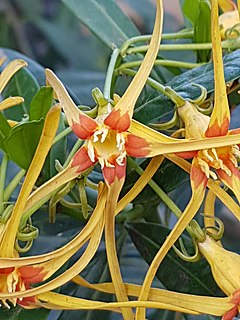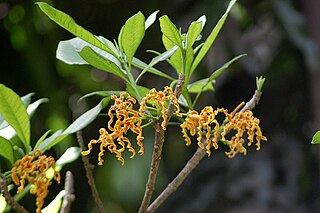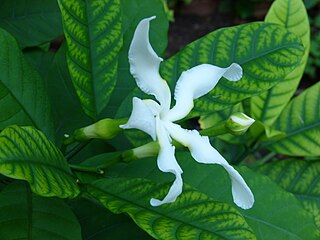
Strophanthus preussii, Preuss' strophanthus, is an evergreen liana up to 12 metres (39 ft) long or a shrub up to 5 metres (16 ft) tall, with a stem diameter up to 2.5 centimetres (1 in). Its fragrant flowers feature a white to orange corolla, red-striped or spotted on the inside. Corollas have very long tails. Vernacular names for the plant include "spider tresses" and "poison arrow vine". Habitats are forested areas from sea level to 1,400 metres (4,600 ft) altitude. Traditional medicinal uses of S. preussii include treatment of gonorrhoea and healing of sores. The plant has also been used as arrow poison. Strophanthus preussii is native to countries of west and central tropical Africa.

Strophanthus sarmentosus grows as either a deciduous shrub or as a liana up to 40 metres (130 ft) long, with a stem diameter up to 15 centimetres (6 in). Its fragrant flowers feature a white to purple corolla, red or purple-streaked on the inside. Vernacular names for the plant include "spider tresses" and "poison arrow vine". Habitats are forested areas from sea level to 1,400 metres (4,600 ft) altitude. The numerous local medicinal uses of S. sarmentosus include treatment of joint pain, head lice, eye conditions and venereal disease. The plant has also been used as arrow poison. Strophanthus sarmentosus is native from west and central tropical Africa to Uganda and Angola.

Strophanthus speciosus, commonly known as the forest poison rope, is a tree, shrub or woody climber which is native to southern Africa.
Strophanthus amboensis grows as a deciduous shrub up to 4 metres (13 ft) tall, or as a liana up to 20 metres (66 ft) long, with a stem diameter up to 20 centimetres (8 in). Its flowers feature an orange-yellow turning purple corolla tube, white-streaked on the inside. Habitats are forest margins, scrubland or rock fissures, from 450 metres (1,480 ft) to 2,000 metres (6,600 ft) altitude. S. amboensis is used in local medicinal treatments for rheumatism, venereal diseases and scabies. The plant has been used as arrow poison. Strophanthus amboensis is native to Democratic Republic of Congo, Angola and Namibia.

Strophanthus boivinii grows as a deciduous shrub or small tree sometimes up to 30 metres (100 ft) tall, with a bole diameter up to 40 centimetres (16 in). Its flowers feature a yellow-orange turning reddish brown corolla tube. Vernacular names for the plant include wood shaving flower. Its habitat is deciduous forests and thickets, from sea-level to 800 metres (2,600 ft) altitude. Strophanthus boivinii is used in local medicinal treatments for gonorrhoea, colic, wounds and itches. The plant is native to Madagascar and is also found in Réunion and Mauritius.
Strophanthus courmontii grows as a deciduous liana up to 22 metres (72 ft) long or as a shrub up to 4 metres (13 ft) tall, with a stem diameter up to 10 centimetres (3.9 in). Its fragrant flowers feature a white turning red and purple corolla tube, yellow with purple streaks inside. Habitats are forests and riverine thickets, from sea-level to 1,400 metres (4,600 ft) altitude. S. courmontii is used in local medicinal treatments for rheumatism and as an aphrodisiac. The plant is native to Kenya, Tanzania, Malawi, Mozambique, Zambia and Zimbabwe.

Strophanthus eminii, Emin's strophanthus, grows as a liana up to 10 metres (33 ft) long or as a shrub or small tree up to 7 metres (23 ft) tall, with a stem diameter up to 6 centimetres (2.4 in). Its fragrant flowers feature a pink with white turning red corolla tube, white turning yellow with red spots and streaks inside. Vernacular names for the plant include "spider tresses" and "poison arrow vine". Its habitat is deciduous woodland or rocky bushland, from 600 metres (2,000 ft) to 1,650 metres (5,400 ft) altitude. Strophanthus eminii is used in local medicinal treatments for snakebites, skin diseases and wounds and also as an anthelmintic. The plant has been used as arrow poison. It is native to Democratic Republic of Congo, Tanzania and Zambia.
Catharanthus lanceus grows as a perennial herb up to 1 metre (3 ft) tall. Its fragrant flowers feature white or cream corolla lobes turning pink, reddish-violet or pink-magenta. Vernacular names for the plant include "lance-leaf periwinkle". Its habitat is on volcanic or burned soil, hillside rocks and in open woodland on ridges. Catharanthus lanceus is found from 750–2,000 metres (2,500–6,600 ft) altitude. The plant is used in local medicinal treatments for toothache, fever and skin diseases, and also as a diuretic. The species is endemic to Madagascar.
Hunteria umbellata grows as either a shrub or small tree up to 22 metres (72 ft) tall, with a trunk diameter of up to 40 centimetres (16 in). Its flowers feature a white, creamy or pale yellow corolla. The fruit is yellow and smooth. Its habitat is forests from sea level to 600 metres (2,000 ft) altitude. Its numerous local medicinal uses include for fever, leprosy sores, stomach and liver problems and as an anthelmintic, especially against internal worms. Hunteria umbellata has been used as arrow poison. The plant's hard wood is used in carving and to make small tools. The species is native to west and west-central tropical Africa.
Hunteria zeylanica grows as either an evergreen shrub or as a tree up to 15 metres (49 ft) tall, with a trunk diameter of up to 34.5 centimetres (13.6 in). Its flowers feature a white corolla. The berries are yellow. Its habitat is forests from sea-level to 350 metres (1,150 ft) altitude. The trees can withstand salinity. Local medicinal uses include for stomach-ache. Hunteria zeylanica wood is used for weapon handles and as firewood. In Africa, the plant is native to Kenya and Tanzania and in Asia it is native to China, India, Sri Lanka, Indochina and western Malesia.
Pleioceras barteri grows as a shrub, liana or small tree up to 4 metres (13 ft) tall. Its flowers feature dark red or violet corolla lobes with yellow apex. Its habitat is forests, bush or open ground in coastal areas from sea level to 500 metres (1,600 ft) altitude. Local traditional medicinal uses include as an emmenagogue, abortifacient and also in the treatment of rheumatism and malaria. Pleioceras barteri is native to tropical West Africa and Cameroon.
Rauvolfia media grows as a shrub or small tree up to 10 metres (33 ft) tall. Its fragrant flowers feature white to dull yellow corolla lobes. Its habitat is dry forest and savanna from sea level to 800 metres (2,600 ft) altitude. Extracts of the plant, mixed with food, have been used to poison pest animals. Rauvolfia media is native to Madagascar and the Comoros.

Tabernaemontana crassa grows as a shrub or small tree up to 15 metres (49 ft) tall, with a trunk diameter of up to 30 centimetres (12 in). Its fragrant flowers feature white to pale yellow corolla lobes. Its habitat is forests or on coastlines from sea level to 2,000 metres (6,600 ft) altitude. Numerous local medicinal uses include as an anaesthetic, as a haemostatic, as an anthelmintic and in the treatment of rheumatism, kidney problems, rickets and conjunctivitis. It has also been used as arrow poison. Tabernaemontana crassa is native to tropical Africa from Sierra Leone east and south to Angola

Tabernaemontana pachysiphon grows as a shrub or small tree up to 15 metres (50 ft) tall, with a trunk diameter of up to 40 centimetres (16 in). Its fragrant flowers feature white to pale yellow corolla lobes. The fruit is green, almost spherical, up to 15 centimetres (6 in) in diameter. Its habitat is forests from sea level to 2,200 metres (7,200 ft) altitude. Its numerous local medicinal uses include as a styptic, and as a treatment for headache, hypertension and to relieve cramps. The species is native to tropical Africa.

Tabernaemontana ventricosa is a plant in the family Apocynaceae. It grows as a shrub or small tree up to 15 metres (50 ft) tall, with a trunk diameter of up to 30 centimetres (12 in). Its fragrant flowers feature white lobes with a pale yellow corolla. The fruit is dark green, with two ellipsoids, up to 10 centimetres (4 in) in diameter. Its habitat is forests from sea-level to 1,850 metres (6,000 ft) altitude. Local medicinal uses include the treatment of wounds, fever and hypertension. The plant is native to tropical central and southern Africa.
Alafia lucida grows as a liana up to 45 metres (148 ft) long, with a stem diameter of up to 18 centimetres (7.1 in). Its fragrant flowers feature a yellow or cream corolla, dark red at the throat. Fruit is dark brown with paired cylindrical follicles, each up to 75 centimetres (30 in) in diameter. Habitat is forests, from sea-level to 2,000 metres (6,600 ft) altitude. Local medicinal uses include as a treatment for jaundice, eye problems and stomach complaints. The plant has been used as arrow poison. A. lucida is found in Liberia, Ivory Coast, Ghana, Togo, Nigeria, Cameroon, Central African Republic, Gabon, Republic of Congo, Democratic Republic of Congo, Uganda, Rwanda, Tanzania and Angola.
Baissea multiflora grows as a shrub up to 6 metres (20 ft) tall or as a liana up to 30 metres (98 ft) long, with a stem diameter of up to 12 centimetres (4.7 in). Its fragrant flowers feature a white, pink or orange corolla. Habitat is in forests from 150 metres (490 ft) to 1,400 metres (4,600 ft) altitude. The plant's numerous local medicinal uses include as a treatment for colic, rheumatism, arthritis, kidney problems, haemorrhoids, lumbago, conjunctivitis, appendicitis, diarrhoea and gonorrhoea. B. multiflora is found in Senegal, the Gambia, Guinea-Bissau, Guinea, Mali, Burkina Faso, Niger, Sierra Leone, Liberia, Ivory Coast, Ghana, Nigeria, Cameroon, the Central African Republic, Gabon, the Republic of Congo, the Democratic Republic of Congo and Angola.
Petchia madagascariensis grows as a shrub or small tree up to 10 metres (33 ft) tall, with a trunk diameter of up to 25 centimetres (9.8 in). Its flowers feature a creamy to yellow corolla. Fruit is orange with paired cylindrical follicles. Habitat is evergreen forest, mostly coastal, from sea-level to 600 metres (2,000 ft) altitude. Local medicinal uses include as a treatment for stomach-ache, gonorrhoea, rheumatism, gout, malaria and as a diuretic and anthelmintic. P. madagascariensis is endemic to Madagascar.

Pleiocarpa mutica grows as a shrub or small tree up to 7.5 metres (25 ft) tall, with a stem diameter of up to 5 centimetres (2.0 in). Its fragrant flowers feature a white corolla. Fruit is yellow to bright orange with paired follicles, each up to 2 centimetres (0.79 in) long. The plant is found in a variety of habitats from sea-level to 600 metres (2,000 ft) altitude. Local medicinal uses include as a treatment for stomach-ache, kidney diseases, malaria, jaundice and as a laxative. P. mutica is found in Sierra Leone, Liberia, Ivory Coast, Ghana, Nigeria, Cameroon, the Central African Republic, Gabon and the Republic of Congo.
Schizozygia is a monotypic genus of plant in the Apocynaceae family found in tropical Africa and the Comoros. As of August 2013 the World Checklist of Selected Plant Families recognises the single species Schizozygia coffaeoides.










